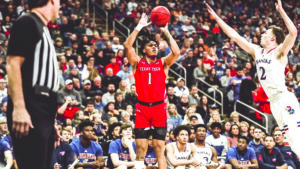By David Mullen
With its origins tracing all the way back to the 1990s, Noah Webster was long gone before the term “bracketology” would become accepted into his tome of terms. Bracketology is a phenomenon that is unmistakably American. Even Canada and Mexico have little interest. They are more concerned with hockey and futbol respectively. In the U.S., it’s about filling out brackets and watching college basketball 18 hours a day.

Photo courtesy of Texas Tech
“March Madness” is here, which concludes on Monday, April 4. The NCAA found that the name “March and early April Madness” just didn’t have the marketability. Despite being the self-righteous guardians of college sports, the NCAA has never been concerned with fairness and accuracy. There are 14 basketball teams in the Big Ten and 10 teams in the Big 12. It doesn’t add up.
But make no mistake. Marketability matters when bracketology is concerned. The NCAA will lead you to believe that every tournament slot not guaranteed by an automatic bid was painstakingly researched before selection and awarded spots solely on merit.
Truth is, not all teams are created equal. The Founding Fathers did not make provisions for executing proper “bracketology” selections, although, even if they had, Harvard, Penn and the College of William & Mary would still have been included on every bracket.
The NCAA has granted Duke the unalienable right to a high tournament seed, the pursuit of post-season life goes to as many Big East Conference teams as possible, and Indiana, Ohio State and Michigan have the liberty to play in the NCAA tournament no matter how worthy.
How else can the NCAA justify nine teams representing the Big Ten in the field of 68 teams in the NCAA Men’s Basketball Tournament? Michigan was 17-14 and don’t deserve to be in. Neither does Indiana, and they just beat Michigan. Ohio State lost four of its last five games, was a mediocre 19-11 yet still got a No. 7 seed.
The Big East has six teams in the tournament, automatic qualifier Villanova, joined by at-large teams Connecticut, Creighton, Providence, Marquette and Seton Hall. While Duke, the Big East and Big Ten are certainly well represented on the bipartisan selection committee, the chair is Tom Burnett, a Houston native, Louisiana Tech grad and retiring commissioner of the Southland Conference.
“By the time we got into bracketing today, we had to look at about 10 different contingencies,” Burnett said on the “NCAA Selection Show” on CBS March 13. “So that’s essentially 10 different seed lists, 10 different brackets that the committee had to go through. And obviously we had to go through all the results of today to get the final data points to complete the process and eventually whittle that down to a couple of brackets and then of course the one we released tonight.”
What process could keep the SMU Mustangs (23-8 overall, 13-4 in the AAC including victories over No. 5 seed Houston and No. 9 Memphis) and the Texas A&M Aggies (23-11 and 9-9 in the SEC with recent conference tournament wins over NCAA No. 2 seeded Auburn and No. 4 seeded Arkansas) be left out of the NCAA tournament?
After not receiving a well-deserved slot in the NCAA tournament, USA Today reported SMU coach Tim Jankovich said: “I saw a group of guys completely devastated and heartbroken. In my eyes, they’re 100 percent an NCAA tournament team. I hope they don’t let what a small committee of others believes change how they feel about themselves. I know that doesn’t bring them the opportunity (to play in March Madness), but there are many things in life that are incredibly unfair. This will happen. You have to be strong and positive to get through it.”
Texas is represented by No. 1 seed Baylor, No. 3 Texas Tech, No. 5 Houston, No. 6 Texas, No. 9 TCU and No. 16 Texas Southern. Tech has a valid shot of advancing deep into the tournament, with a potential matchup versus Duke, the New York Yankees of college basketball.
On March 17, a field of 64 teams believed they had a shot to cut down the nets at the Caesars Superdome on Monday, April 4. Despite the selection committee’s love for the Big Ten, Big 12 and the Blue Devils, the only teams with a legitimate shot to make the Final Four from that group, in my opinion, are Iowa and Villanova.
The most intriguing team with local interest is not defending National Champion Baylor, but the Texas Tech Red Raiders. Tech will probably have to beat retiring coaching legend Mike Krzyzewski of Duke and No. 1 seed Gonzaga to get to the big dance, but they have the right steps.
No. 5 Iowa has a very manageable route to New Orleans, with Providence, Kansas and Auburn creating roadblocks. With sophomore forward Keegan Murray averaging 23.4 ppg and a tough interior game, I think the Hawkeyes make it to the Final Four. Teams will be on the lookout for last year’s Cinderella team, the No. 4 UCLA Bruins (25-7), but I think they have a genuine chance at going to the big dance.
Arizona will beat Iowa, and Gonzaga will upend UCLA, and two teams west of the Rocky Mountains will play for the National Championship. In a season where pundits say more than a dozen teams have a chance at the championship, the top two No. 1 seeds will play in the finals. In the end, the National Championship trophy will head to Tucson with the Arizona Wildcats of the underappreciated Pac-12.
Webster didn’t consider the term bracketology when An American Dictionary of the English Language was first published in 1829. But Webster did go to Yale, which is a No. 14 seed in the 2022 March Madness tournament, while SMU and Texas A&M were not granted an entry.
